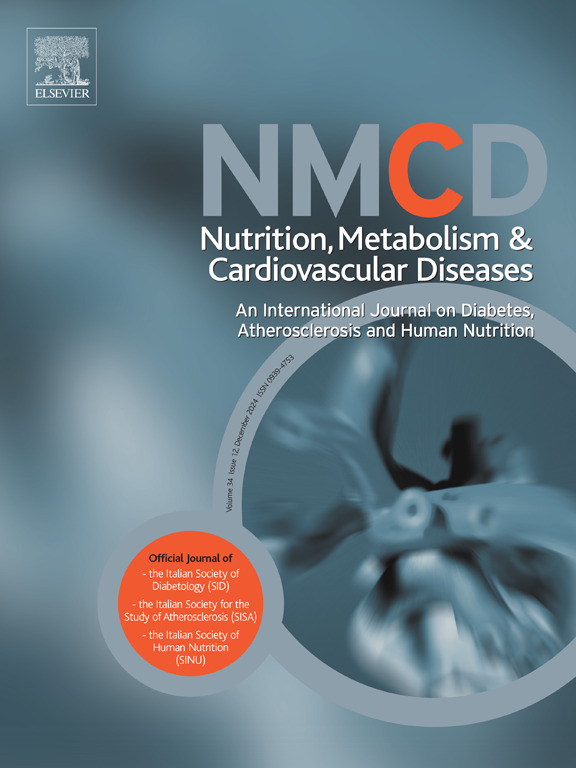8-hydroxy-2′-deoxyguanosine, a biomarker of oxidative DNA injury, in diabetic kidney disease
IF 3.3
3区 医学
Q2 CARDIAC & CARDIOVASCULAR SYSTEMS
Nutrition Metabolism and Cardiovascular Diseases
Pub Date : 2025-02-01
DOI:10.1016/j.numecd.2024.08.015
引用次数: 0
Abstract
Background and aims
To gain insight into the extent of oxidative stress and DNA damage in diabetic kidney disease (DKD), a serious complication of diabetes, we compared the levels of the oxidative stress-related metabolite 8-hydroxy-2′-deoxyguanosine (8-OHdG) in a case-control study accurately matching diabetic patients with and without renal complications.
Methods and results
We analyzed serum 8-OHdG in relation to clinical indicators of kidney function in a group of type-2 diabetes patients including 33 patients with DKD and 33 without DKD.
Circulating levels of 8-OHdG were higher in patients with DKD than in those without (4.6 ± 0.7 ng/mL vs 4.0 ± 0.8 ng/mL, p = 0.002). In a logistic regression analysis adjusting for potential confounders, 8-OHdG was associated with DKD (OR: 2.90, 95%CI:1.15–7.34; p = 0.02) and in a linear regression model, a 1 ng/mL increase of this biomarker entailed a reduction of 11.5 mL/min/1.73 m2 in the renal filtration rate. Furthermore, an interaction analysis showed that glycated hemoglobin was a modifier of the relationship between 8-OHdG and study outcomes (p for effect modification = 0.02).
Conclusion
This study supports the role of oxidative stress in the pathogenesis of diabetic nephropathy and highlights the potential of serum 8-OHdG as a biomarker for assessing oxidative stress and DNA damage in patients with diabetes and renal complications.
糖尿病肾病中氧化 DNA 损伤的生物标志物--8-羟基-2′-脱氧鸟苷
糖尿病肾病(DKD)是糖尿病的一种严重并发症,为了深入了解糖尿病肾病中氧化应激和 DNA 损伤的程度,我们在一项病例对照研究中比较了氧化应激相关代谢物 8-羟基-2′-脱氧鸟苷(8-OHdG)的水平,该研究精确匹配了有肾脏并发症和无肾脏并发症的糖尿病患者。我们分析了一组 2 型糖尿病患者中血清 8-OHdG 与肾功能临床指标的关系,其中包括 33 名 DKD 患者和 33 名非 DKD 患者。DKD患者血液循环中的8-OHdG水平高于非DKD患者(4.6 ± 0.7 ng/mL 4.0 ± 0.8 ng/mL,p = 0.002)。在调整潜在混杂因素的逻辑回归分析中,8-OHdG 与 DKD 相关(OR:2.90,95%CI:1.15-7.34;p = 0.02),在线性回归模型中,该生物标志物每增加 1 纳克/毫升,肾脏滤过率就会降低 11.5 毫升/分钟/1.73 米。此外,交互作用分析表明,糖化血红蛋白是 8-OHdG 与研究结果之间关系的修饰因子(效应修饰 p = 0.02)。这项研究证实了氧化应激在糖尿病肾病发病机制中的作用,并强调了血清 8-OHdG 作为生物标记物评估糖尿病和肾脏并发症患者氧化应激和 DNA 损伤的潜力。
本文章由计算机程序翻译,如有差异,请以英文原文为准。
求助全文
约1分钟内获得全文
求助全文
来源期刊
CiteScore
6.80
自引率
2.60%
发文量
332
审稿时长
57 days
期刊介绍:
Nutrition, Metabolism & Cardiovascular Diseases is a forum designed to focus on the powerful interplay between nutritional and metabolic alterations, and cardiovascular disorders. It aims to be a highly qualified tool to help refine strategies against the nutrition-related epidemics of metabolic and cardiovascular diseases. By presenting original clinical and experimental findings, it introduces readers and authors into a rapidly developing area of clinical and preventive medicine, including also vascular biology. Of particular concern are the origins, the mechanisms and the means to prevent and control diabetes, atherosclerosis, hypertension, and other nutrition-related diseases.

 求助内容:
求助内容: 应助结果提醒方式:
应助结果提醒方式:


